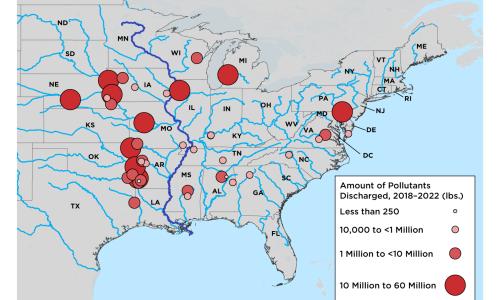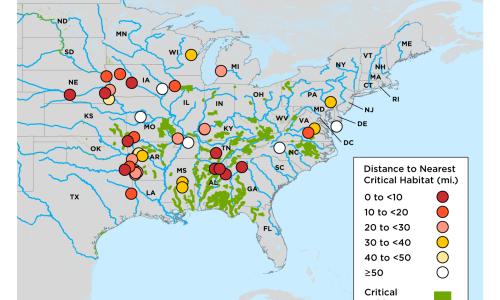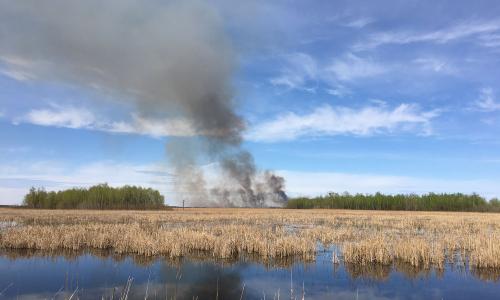Tyson Foods, the nation’s largest meat and poultry producer, released hundreds of millions of pounds of pollutants from its slaughterhouses and processing plants into local waterways across the United States between 2018 and 2022.
Water pollutants from Tyson plants pose a risk to people and the environment and include large amounts of nitrogen and phosphorus. These nutrients feed algal blooms that clog water infrastructure, exacerbate asthma and other respiratory conditions, and contribute to dead zones that harm fish, shellfish, and people. Many of these facilities are also located close to federally defined critical habitats for endangered or threatened species.
This analysis adds to a broader critique of Tyson Foods and the impact of this megacorporation on communities, consumers, farmers, and workers. Policymakers can reduce the damage Tyson causes by tightening wastewater pollution standards, better enforcing discharge limits, and cracking down on the corporate consolidation that enables Tyson’s excesses.
Waste Deep
If you have ever purchased meat or poultry from the grocery store or enjoyed chicken nuggets from a fast food restaurant, chances are you are a consumer of Tyson Foods (Miller 2018). Tyson is one of the nation's largest meat and poultry producers—and the world's second largest—operating 123 US processing plants with more than 124,000 employees (The National Provisioner 2023; Newsweek n.d.; Stillerman 2022; Shahbandeh 2023). In 2023, it boasted $52.88 billion in revenue, a total that earned this publicly traded consolidated megacorporation the number 80 spot in the Fortune 500 list of the highest revenue-generating companies in the United States and provided lavish compensation for its executives (Macrotrends n.d.; Boehm 2021; 50Pros 2024; Souza 2022). However, that prosperity comes at a high price—especially for communities burdened by water pollution from Tyson processing plants.
Meat Processing and Water Pollution
The agricultural industry is the largest consumer of freshwater worldwide, and meat and poultry processors such as Tyson Foods account for nearly one-third of that freshwater consumption. Animal processing plants can generate millions of gallons of wastewater every day by engaging in activities such as washing animals, cleaning meat and animal products, sanitizing equipment, and scrubbing work areas within the facility (Food and Agriculture Organization of the United Nations 2017; Gerbens-Leenes, Mekonnen, and Hoekstra 2013; Burkhart et al. 2018). Wastewater discharged from meat processing plants is a complex mixture, often including the following:
- Nutrients such as nitrogen and phosphorus, which can deplete the oxygen in waterways and harm marine life (Burkhart et al. 2018)
- Animal body parts and byproducts, such as blood and feces
- Pathogens and microorganisms, including E. coli and Enterococcus (Environment America 2020)
Between 2018 and 2022, Tyson processed billions of animals, generating enormous quantities of wastewater—according to the US Environmental Protection Agency (EPA), over 87 billion gallons (Tyson Foods n.d.; US EPA n.d.). That is enough to fill more than 177,000 Olympic swimming pools (City of Corvallis, Oregon n.d.). In a single year, 2022, Tyson discharged over 18.5 billion gallons of wastewater. This wastewater contains millions of pounds of toxic pollutants that damage the environment and threaten the health of plants, animals, and people (Burkhart et al. 2018).
To investigate the extent of Tyson's water pollutant load, we used publicly available data from the EPA to estimate the quantity and geospatial distribution of Tyson's water discharges from 2018 to 2022. This investigation included Tyson facilities that piped wastewater directly into waterways, threatening surface and groundwater quality (Burkhart et al. 2018). Our analysis found that over five years, Tyson's meat processing plants dumped 371.72 million pounds of pollutants into waterways across the United States, with over half of the pollutant load concentrated in just three states: Nebraska, Illinois, and Missouri.
Because discharges directly from meat processing plants are only a fraction of the meat processing industry's overall water pollution, our analysis is likely a drastic underestimation of Tyson's true environmental impact. Large industrial meat processers such as Tyson Foods procure slaughter animals from concentrated animal feeding operations (CAFOs), which are sources of significant air, water, soil, noise, and odor pollution that harm the environment and threaten human health (Son, Miranda, and Bell 2021). The feed for these slaughter animals is cultivated using harmful industrial agriculture practices—such as the overapplication of synthetic nitrogen, phosphorus, and manure fertilizer—which can run off into waterways, resulting in serious environmental and human health issues and detrimental impacts to the economy.
Previous research by the Union of Concerned Scientists (UCS) concluded that nitrogen fertilizer runoff from the Midwest causes up to $2.4 billion per year in damages to fisheries and marine habitats in the Gulf of Mexico (Boehm 2020). Earlier research estimated a 10- to 15-fold increase in reactive nitrogen in US rivers over the past century (Sobota et al. 2015). Further, the EPA has highlighted states where groundwater sources exceed the maximum contaminant level for nitrates, which are formed when excess fertilizers decompose, threatening drinking water safety (US EPA 2023a; Schechinger and Cox 2018).
This pollution creates additional burdens on traditionally marginalized communities living in close proximity to these facilities. In 2021, the EPA conducted an environmental justice screening of the meat and poultry product industry and found that almost 75 percent of these water-polluting facilities are located within one mile of communities that are disproportionately impacted by economic, health, and/or environmental burdens (US EPA 2021). The environmental injustices of the meat and poultry industry have been well documented, including through personal stories of community members harmed by this polluting industry (Chamanara, Goldstein, and Newell 2021; Nicole 2013; Struthers Montford and Wotherspoon 2021; Andiman, Rutinel, and Saifuddin 2023; Burkhart et al. 2018).
The EPA estimates that only about 300 of the 7,000 meat, beef, and poultry processing businesses in the United States have mandatory monitoring reporting requirements and regulatory limits for pollution (US EPA 2021). To help address the loopholes that allow Tyson and other meat processing plants to pollute waterways and threaten the environment and health, we identify policy recommendations that can help reduce the harms from the meat and poultry processing industry and foster a more sustainable and resilient food and farm system.
Tyson's Prolific Pollution
Between 2018 and 2022, 41 Tyson-owned meat processing plants released more than 371.72 million pounds of pollutants directly into US waterways, including 138.07 million pounds of chlorides, 82.51 million pounds of dissolved solids, and 40.26 million pounds of sulfates (Table 1; see appendix for methodology). Although trace amounts of chlorides, solids, and sulfates are naturally present in surface waters, excessive concentrations can be detrimental to water quality and can contaminate drinking water. Too much chloride can harm plants and animals, and can affect water infrastructure such as pipes, because it increases water's corrosivity (Missouri Department of Natural Resources n.d.; Hong et al. 2023; Water Resources Mission Area 2019a). Overabundant sulfates in drinking water can cause gastrointestinal problems in humans, and excessive dissolved solids in drinking water may contain heavy metals or other toxic substances (Minnesota Department of Health 2022; Wang 2021).
Table 1

* We report pollutant category "Chlorides and sulfates" separately from categories "Chloride" and "Sulfate" to reflect differences in reporting structures for different facilities. This does not reflect duplicate data (EPA, personal communication to the author, January 11, 2024).
SOURCE: US EPA 2023c.
Where Tyson Pollutes
Tyson processing plants discharged millions of pounds of pollutants into waterways from facilities in 17 states between 2018 and 2022 (Table 2). Almost a third of this load—111.22 million pounds of pollutants—was discharged into rivers, lakes, ponds, and other water bodies in Nebraska.
Table 2
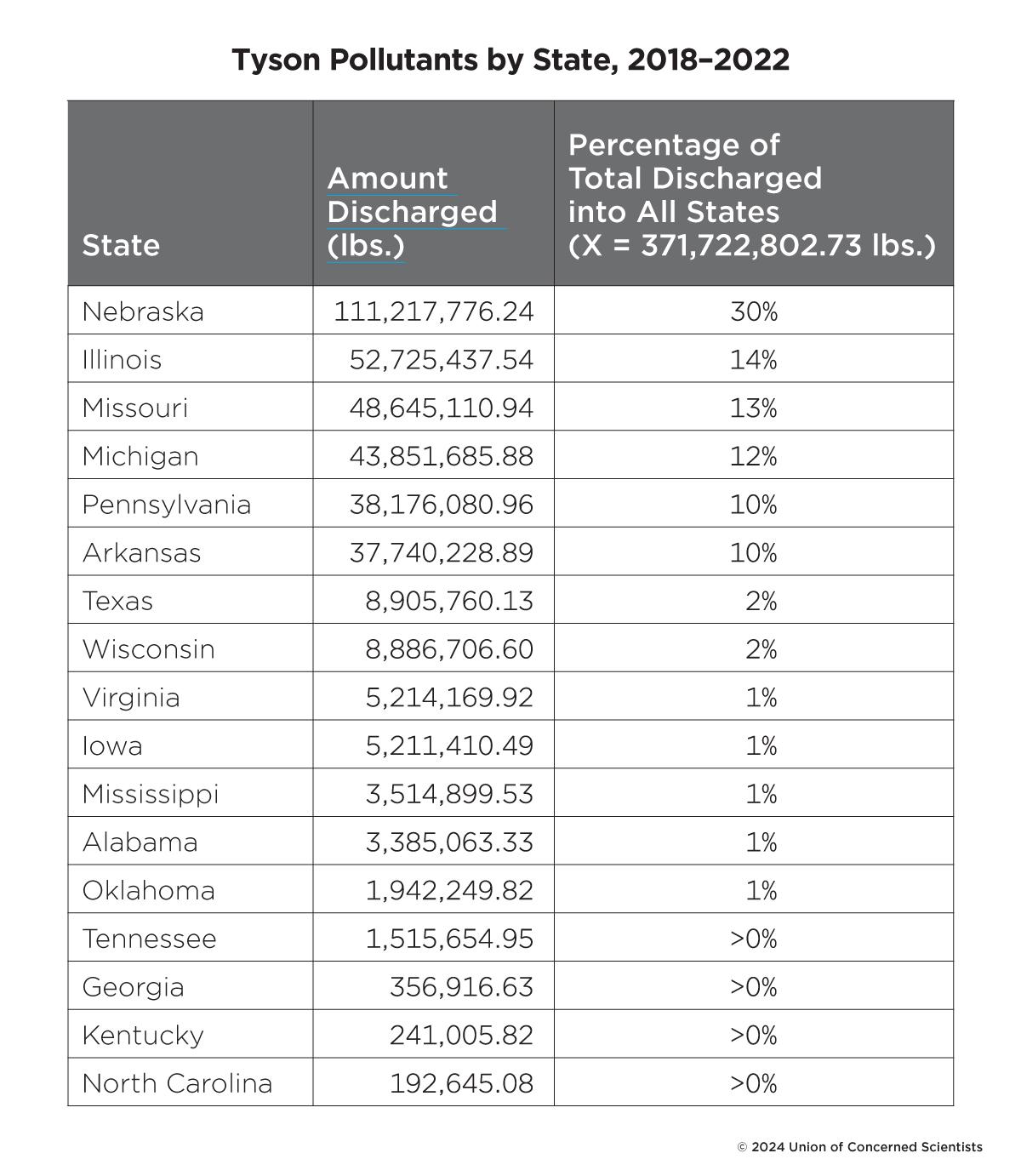
SOURCE: US EPA 2023c.
The largest single source of Tyson's water discharges in Nebraska during the study period was the Dakota City Tyson Fresh Meats facility, one of the nation's largest processing plants. It made headlines in April 2020 for a deadly and widespread COVID-19 outbreak that sickened 15 percent of its workforce (Dreeszen 2020). This single plant dumped over 60 million pounds of pollutants into Nebraska waterways during the study period (Figure 1). Individual high-volume emitting plants also propelled Tyson's discharge totals in Illinois (the Tyson Fresh Meats facility in Joslin), Michigan (the Hillshire facility in Zeeland), and Pennsylvania (the Tyson Foods New Holland Complex). Combined, these four plants released 195 million pounds of pollutants into community waters where over 13,0001 people live.
Figure 1
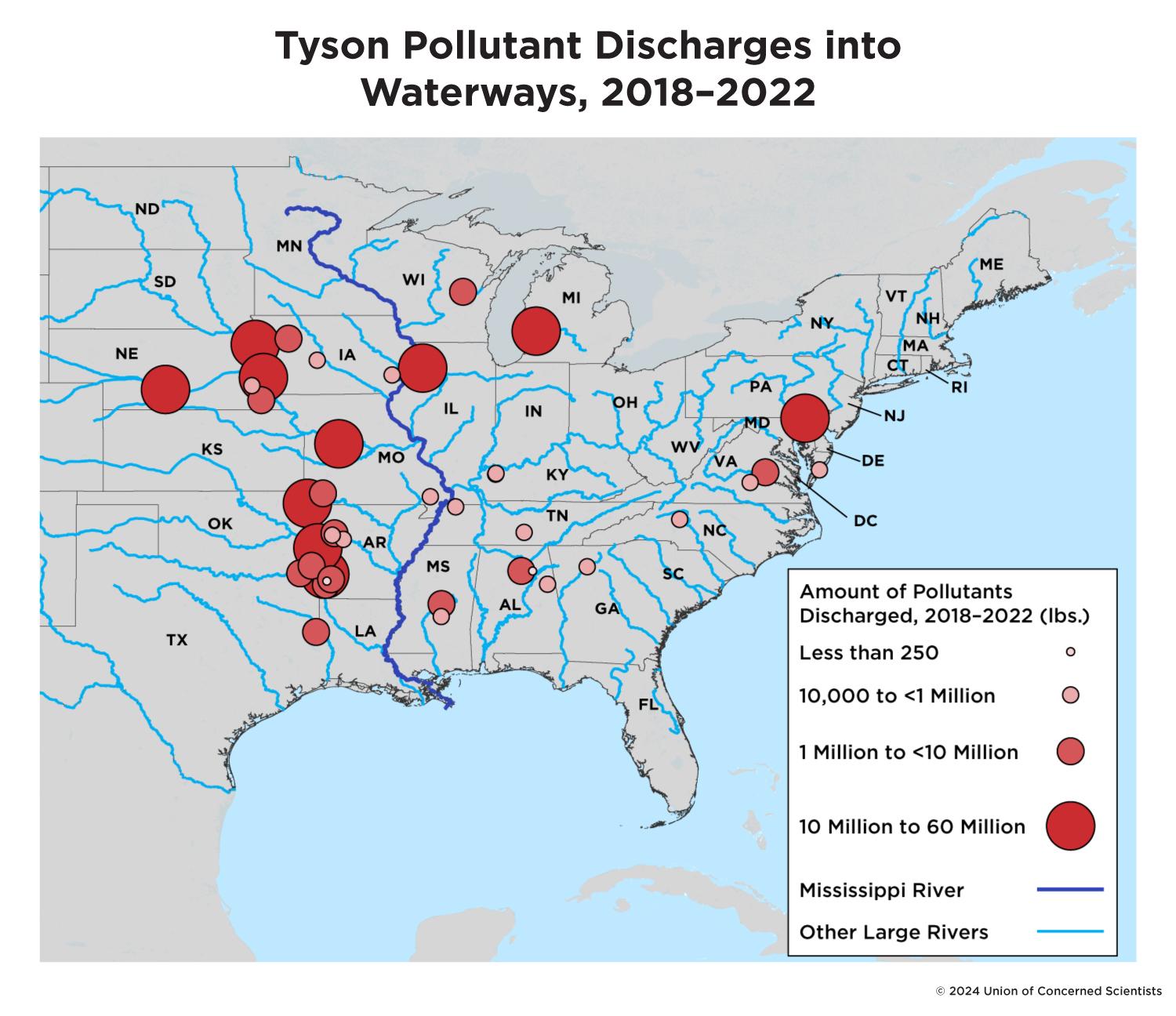
Note: An interactive version is available at http://bit.ly/tysonmaps.
SOURCE: US EPA 2023c.
Tyson Pollutes; Life Suffers
The meat and poultry industry is a primary industrial contributor of nitrogen and phosphorus water pollution, and Tyson processing plants are no exception (US EPA 2021). Between 2018 and 2022, Tyson plants discharged 34.25 million pounds of nitrogen and 5.06 million pounds of phosphorus into US waterways (Table 1). While nitrogen and phosphorous are naturally occurring nutrients, water bodies that contain excesses of these chemicals can be harmful to plant and animal life.
The process by which a water body becomes overburdened with these nutrients is called eutrophication (Water Resources Mission Area 2019b). In eutrophic waters, excess nitrogen and phosphorus feed algal blooms that cover the water body in a colored film, clogging water infrastructure and blocking sunlight to the water habitat below. When the algae die and decompose, bacteria proliferate, depleting the oxygen in the water and releasing carbon dioxide (National Ocean Service 2024). As a result, fish and other aquatic life suffocate and die in these dead zones, where life struggles to survive (US EPA 2013a).
Tyson discharged large amounts of nitrogen, phosphorus, and other pollutants into waterways in the Midwest, an area of the country that is already saturated with nitrogen and phosphorus from excessive fertilizer use, primarily from large industrial monoculture corn and soy farms (Calderon 2021). The nutrient pollution from Tyson's processing plants in the Midwest can travel along river-to-river pathways and ultimately deposit into the Gulf of Mexico (Figure 1). This contributes to the Gulf's massive and persistent dead zone. In 2023, scientists estimated the Gulf of Mexico's dead zone stretched over 3,058 square miles (National Centers for Coastal Ocean Science 2023).
Nitrogen and phosphorus pollution poses direct threats to human health as well. Harmful algal blooms that result from nutrient overload are linked to increases in respiratory symptoms such as pneumonia, bronchitis, and asthma among people living close to affected waters (Kirkpatrick et al. 2006). The nutrients themselves can also cause human health problems. For example, nitrate is a chemical form of nitrogen that is toxic at high levels, and Tyson processing plants released 4.55 million pounds of nitrate nitrogen into US waters between 2018 and 2022 (Table 3).
Nitrate contamination of US drinking water is a serious environmental and public health issue, especially for people who rely on private well water and those who live in agricultural areas (Weir Schechinger 2020). Nitrate can leach from surface to groundwater, contaminating the aquifers people rely on for drinking water (Abascal et al. 2022). Drinking water contaminated with nitrate has been linked to health outcomes such as the blood disorder methemoglobinemia and neural tube abnormalities in infants, and colorectal cancer and thyroid disease in adults (Ward et al. 2018).
While the EPA sets an enforceable maximum contaminant level (MCL) for nitrate in drinking water (10 milligrams/liter), research has found that low-level chronic exposure to nitrate below the MCL is associated with an increased risk of cancer (Temkin et al. 2019). In Iowa, recent research has estimated that exposure to nitrate in drinking water causes up to 300 cases of cancer each year (Union of Concerned Scientists 2021). In Nebraska, where Tyson plants released 4.06 million pounds of nitrate into waterways between 2018 and 2022, research has identified possible associations between high levels of nitrate in waterways and elevated incidence of pediatric cancer (Table 3) (Ouattara and Rogan 2021).
Table 3
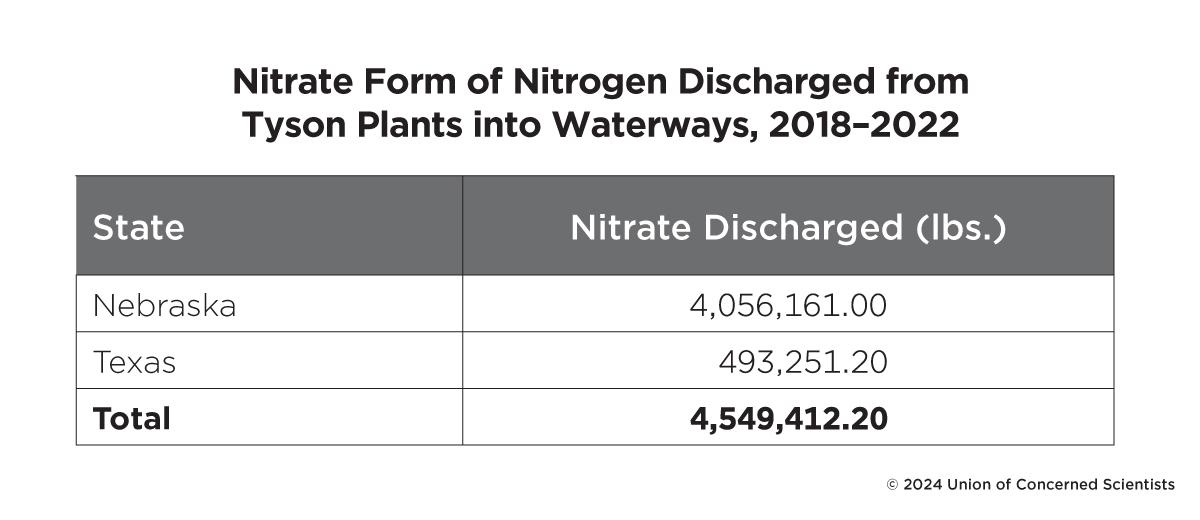
Note: We include nitrates in the overall "nitrogen" pollutant category in other tables in this report.
SOURCE: US EPA 2023c.
Tyson's water pollution includes bacteria and other microorganisms that overconsume oxygen in waterways. Biological oxygen demand (BOD) indirectly measures these oxygen-depleting microorganisms in wastewater (Water Science School 2018; Kiepper 2022). High BODs are associated with elevated quantities of microorganisms that consume significant amounts of oxygen, leaving less oxygen available to support aquatic plant and animal life. From 2018 to 2022, Tyson's BOD was a staggering 15.24 million pounds (Table 1). With this biological load compounding the oxygen-depleting effects of its nitrogen and phosphorous pollution, Tyson is truly sucking the life out of aquatic habitats.
Many of Tyson's water-polluting processing facilities are located close to federally defined critical habitats for endangered or threatened species (Figure 2) (US FWS 2017). For example, between 2018 and 2022, the Tyson Fresh Meats facility in Lexington, Nebraska, discharged over 22.90 million pounds of pollutants into waterways less than a mile and a half from a critical habitat for the endangered whooping crane (Grus americana) (Nebraska Game and Parks Commission n.d.). Even Tyson facilities that dump pollutants into water bodies further from critical habitats pose risks, since water can carry pollutants to these habitats through interconnected rivers, streams, and underground water pathways (Destouni et al. 2010). The proximity of Tyson's polluting plants to essential habitats for species conservation adds a further source of stress to those already burdened species.
Figure 2
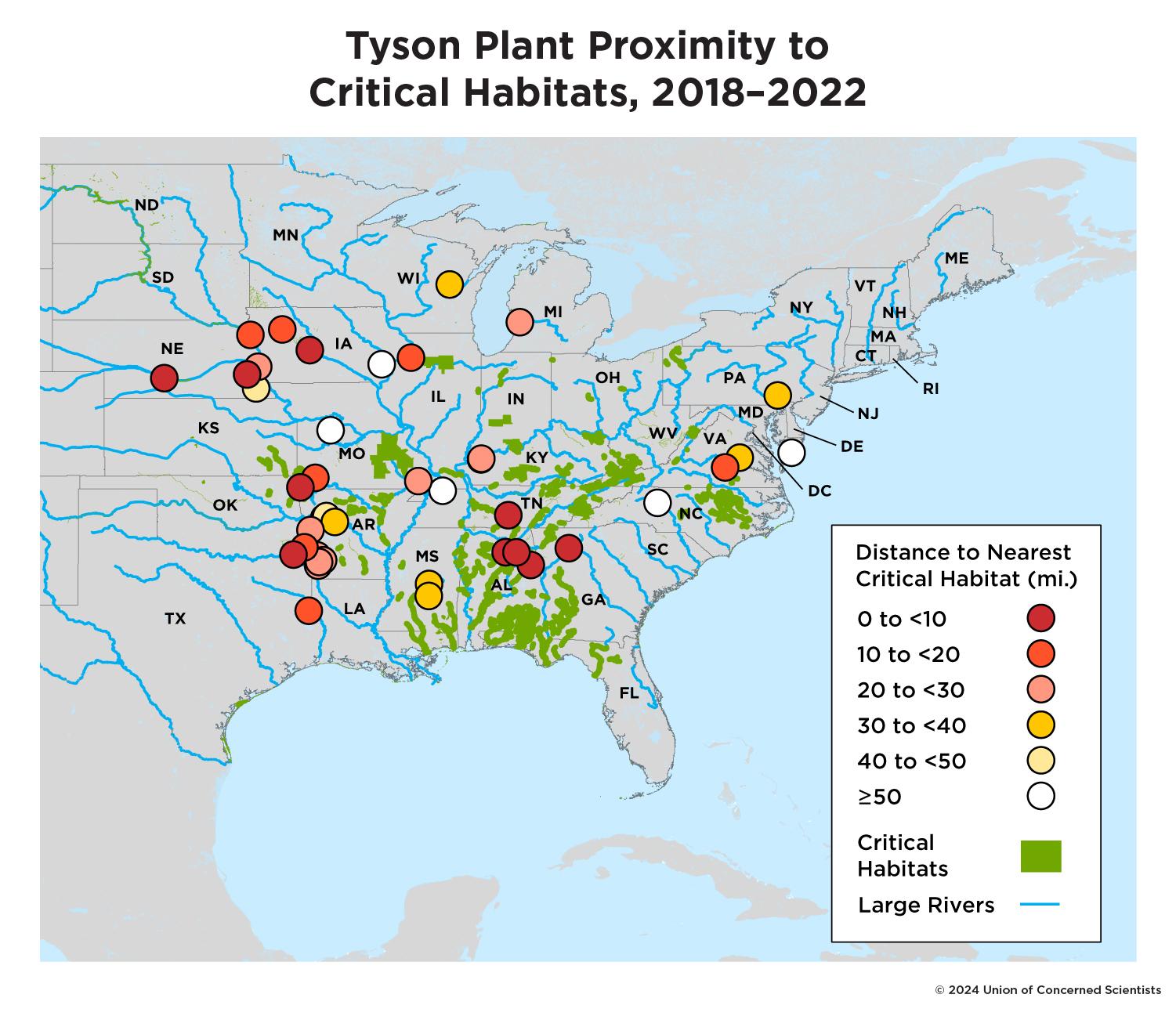
Note: An interactive version is available at http://bit.ly/tysonmaps.
SOURCE: US EPA 2023c (Tyson plant locations); US FWS, NOAA, and US EPA 2023 (critical habitat locations).
Guilty, Fined, but Unimpeded
Tyson Foods has come under legal scrutiny on multiple occasions for violating the Clean Water Act (CWA) and water pollution regulations. Violations by Tyson-owned plants include exceeding effluent limits for waste discharges into waterways in numerous instances, improperly reporting discharges, and polluting nearby waters (US SEC n.d.). Over the past decade, Tyson's legacy of water pollution has prompted shareholders to repeatedly urge the corporation to establish a water stewardship policy, but these shareholders have been voted down (Investor Advocates for Social Justice 2017; Tyson Foods Inc. 2017; Tyson Foods Inc. 2018). In the company's most recent sustainability report, Tyson indicated it was working to address water quality where it operates and put forward a goal to "develop Contextual Water Plans at 11 high-risk U.S. locations by 2025" (Tyson Foods Inc. 2022). It did not identify those locations or provide details about the plans.
Meanwhile, Tyson continues to pollute in violation of state and federal laws governing water quality, even as its offenses result in steep fines. For example, in 2018, the Department of Justice ordered Tyson to pay a $2 million criminal fine plus $500,000 in damages after discharges at Tyson's processing facility in Monett, Missouri, poisoned Clear Creek with ammonia, resulting in the death of approximately 108,000 fish (US Department of Justice 2018). But Tyson has vast wealth at its disposal, so it can withstand even multimillion-dollar pollution penalties. In 2021, Tyson paid $3 million to settle a lawsuit over an illegal wastewater discharge that killed 200,000 fish in Alabama's Black Warrior River (Alabama Attorney General Steve Marshall 2021). The fine represented just 0.006 percent of its $47.05 billion in revenue that year (Macrotrends n.d.).
It Gets Worse
The hundreds of millions of pounds of pollutants that we report here represent only a fraction of Tyson's environmental pollution. We relied on the EPA's National Pollutant Discharge Elimination System (NPDES) database (see appendix) to gather water pollution data for Tyson's meat processing plants. So our findings are limited to only the specific pollutants the CWA mandates that Tyson report. Thus, our analysis likely underestimates the actual water pollution of Tyson plants because it does not capture pollution from plants that are not required to obtain NPDES permits (e.g., plants that do not exceed EPA and state minimum daily discharge limits and plants that discharge directly to municipal waste treatment systems; US EPA 2014; US EPA 2015). This may explain why our search captured water pollution information for only a small fraction of the 123 meat processing plants owned by Tyson in the United States (Stillerman 2022).
This report considers water pollution only from Tyson-owned facilities. It does not examine water pollution from facilities in Tyson's supply chain that are not directly owned by the Tyson corporation. For example, our methods do not capture the water pollution from CAFOs that supply animals for slaughter at Tyson facilities (Hall et al. 2021). Furthermore, we limited our investigation to water pollution, but Tyson's facilities pollute more than just water. Tyson also has a history of polluting the air around its facilities and has paid millions in fines for Clean Air Act violations (US EPA 2013a). Additionally, research has identified the Tyson corporation as a top emitter of heat-trapping gases (IATP, GRAIN, and Stiftung 2017). So while the water pollution we identified in this report is egregious, it is only a drop in the toxic bucket of Tyson's true environmental impact.
A Path Forward
Tyson's runaway environmental pollution can be curbed by expanding water pollution regulations (Shapiro 2022). Fortunately, execution of this approach is currently underway (Woods 2024). In response to a successful lawsuit that found current regulations allowed Tyson and other meat and poultry plants to pollute lakes, rivers, streams, and community water resources, the EPA proposed updates to the pollution regulations governing the industry for the first time in almost two decades (US EPA 2023b; EIP 2023). Proposed regulatory changes include tighter limits on the discharge of nitrogen, phosphorus, and other pollutants (such as fecal matter) that Tyson and other meat processing plants dump into waterways.
To ensure that new regulations effectively address the dire need for more pollution control, the final regulations should reflect the current science, including available technologies for pollution detection and wastewater treatment methods. The EPA should solicit input from the people who are most impacted by meat producer pollution—including plant workers and community members who live with Tyson's dirty water—and incorporate their feedback into regulatory proposals and updates (Woods 2024; Jett 2021; WVTM 13 Digital 2021). For example, the EPA could gather feedback by convening meetings in places such as Delaware, Florida, and Illinois, where slaughterhouse water pollution has contaminated drinking water wells, killed hundreds of thousands of fish, and poisoned lakes, rivers, and streams (Burkhart et al. 2018). Stronger regulatory standards will allow the EPA to begin revoking Tyson's license to pollute the environment.
As a multibillion-dollar company, Tyson can treat even hefty fines and penalties for polluting the environment as simply the cost of conducting business its way (WVTM 13 Digital 2021). Tyson's deep pockets allow it to pay to play by its own rules in other arenas too, including futures markets, child labor, and worker safety (McVan 2021; US Department of Labor 2013; Driver 2022). As detailed in previous UCS reports—such as Tyson's Need for Feed and Tyson Spells Trouble for Arkansas—Tyson employs aggressive acquisition and consolidation to build and maintain its near-monopoly status as a megacorporation that can afford to circumvent rules and regulations (DeLonge and Stillerman 2022; Boehm 2021).
The good news is that the federal government has the power to limit the influence of megacorporations through antitrust regulations that target monopolies. Federal antitrust laws—including the Sherman Antitrust Act, the Clayton Antitrust Act, and the Federal Trade Commission Act—grant the US Department of Justice and the Federal Trade Commission the legal authority to scrutinize and regulate Tyson's antitrust activities that stifle competition and threaten free and open markets (Federal Trade Commission 2013; Federal Trade Commission 2021).
Additionally, the Packers and Stockyards (P&S) Act restricts monopolies and anticompetition practices specifically in the meat and poultry industry (USDA and AMS 2023). The US Department of Agriculture (USDA) should expeditiously finalize and implement proposals to improve enforcement of the P&S Act to prevent Tyson from further consolidating and escalating monopolistic practices that seek to maximize its profits at the expense of the environment, farmers, consumers, and communities (Federal Register 2022; USDA 2021a; Lakhani 2021).
The need to enact a new five-year food and farm bill provides Congress with a historic opportunity to put limits on Tyson Foods and other giant corporations that have hijacked our food and farming system for profit. A new food and farm bill can address consolidation in the meat and poultry industry and the resultant power it gives companies such as Tyson Foods to pollute at will and otherwise harm communities, consumers, farmers, and workers (Union of Concerned Scientists 2023). To help achieve these goals, the next food and farm bill should include the following provisions:
-
Agriculture Resilience Act: This legislation (H.R. 1840/S. 1016) is a comprehensive bill focused on climate resilience and soil health and provides small- and medium-scale farmers with strategies and funding to thrive, even under a changing climate (Congress n.d. b; Goswami 2023). The bill promotes small-scale poultry and meat processing by creating new grant programs for small slaughtering establishments. Other key provisions of the bill focus on manure management in animal grazing systems and technical assistance for animal farmers.
-
Farm System Reform Act: This legislation (H.R. 797/S. 271) aims to strengthen the P&S Act by curbing the monopolistic practices of meatpackers, for example, by placing a moratorium on large animal factory farms and CAFOs that represent the supply chain for Tyson Foods and other giant processors (Farm System Reform Act of 2023 2023).
-
Protecting America's Meatpacking Workers Act: This bill (H.R. 798/S. 270) creates safer working conditions in meatpacking facilities by requiring, for example, the Occupational Safety and Health Administration to develop enforceable workplace standards for the meatpacking industry (Congress n.d. a). The bill also increases funding for programs that support regional food systems that allow small- and medium-scale farmers and ranchers to thrive despite the anticompetitive business practices of Tyson and other megacorporations.
-
Strengthening Local Processing Act: This bill (H.R. 945/S. 354) is aimed at diversifying the US meat processing industry by increasing local slaughterhouse options for producers (Pingree 2023). Under the current system, because of the limited number of federally or state-inspected slaughterhouses, some farmers and ranchers must travel hundreds of miles to the nearest slaughterhouse. This bill increases federal cost sharing to help fund state inspection facilities and decrease the cost of shipping for farmers and ranchers. Additionally, the bill creates training programs to bolster the meat processing workforce. That assistance includes grants that support training specifically for small-scale farmers and ranchers, which can help dilute the market power of polluting megacorporations such as Tyson Foods.
Under the Biden administration, the USDA has recognized how the consolidated meat and poultry industry exemplified by Tyson hurts farmers, consumers, and the environment, and how increased competition could help break these megacorporations' choke hold on our food system (The White House 2022). Accordingly, the USDA has made substantial investments to expand small- and medium-scale meat and poultry processing. Since 2021, the department has committed more than a billion dollars to make meat processing more accessible, expand national meat processing capacity, and increase competition to reduce consolidation, and this work includes the USDA's Build Back Better Initiative (USDA n.d.; USDA 2021b). In 2023, the department announced new grant programs that will provide up to $125 million in grants to promote local meat and poultry markets and to expand opportunities for smaller-scale, local, and regional livestock producers, including funds to promote Indigenous peoples' meat industry (The White House 2022).
The USDA should continue to increase investments in smaller-scale meat processing and other agricultural sectors to provide farmers, ranchers, and meatpackers opportunities to build resilient new markets. These efforts will help curb the power of Tyson Foods and other giant processors in our food system and reduce their negative impacts on the environment.
Omanjana Goswami is an interdisciplinary scientist in the UCS Food and Environment Program. Stacy Woods is research director for the program.
1 Tyson Fresh Meats: discharged 60,594,552.88 lbs., located in Dakota City, NE, population 2,081; Tyson Fresh Meats Joslin: discharged 52,725,437.54 lbs., located in Joslin, IL, population 85; Hillshire Zeeland: discharged 43,851,685.86 lbs., located in Zeeland, MI, population 5,719; Tyson Foods New Holland Complex: discharged 38,176,080.96 lbs., located in New Holland, PA, population 5,743.
Acknowledgments
This analysis was made possible by the generous support of Grantham Foundation for the Protection of the Environment, W. K. Kellogg Foundation, 11th Hour Project/The Schmidt Family Foundation, and UCS members.
The authors of this report would like to thank Karen Perry Stillerman, Kyle Ann Sebastian, Ricardo Salvador, Darya Minovi, Melissa Finucane, Joy McNally Brandow, and Bryan Wadsworth for their help reviewing and refining the text and messaging of this report. We would like to thank our external reviewers, Lara Bryant and Susan Lee, for their thoughtful feedback on the report and geospatial visualization of the data. We'd like to thank Cynthia Williams for her work on copyedits of this report.
The opinions expressed herein do not necessarily reflect those of the organizations that funded the work or the individuals who reviewed it. The Union of Concerned Scientists bears sole responsibility for the report's content.
Appendix: Methodology
The Clean Water Act requires facilities, including meat processing plants and other point source polluters, to obtain permits through the National Pollutant Discharge Elimination System and submit monthly Discharge Monitoring Reports (DMRs) (US EPA 2023e; US EPA 2014). We used the US Environmental Protection Agency's Water Pollutant Loading Tool to gather facility-level water discharge data from DMRs (US EPA 2023c). The loading tool aggregates the information supplied by these facilities and makes that data available to the public.
We obtained annual water discharges for all pollutants from Tyson facilities from 2018 to 2022, the last five years of data available at the time of analysis. We retained discharge data for meat and poultry facilities operated by Tyson Foods and two subsidiaries: Hillshire Brands and Tecumseh Poultry. Another Tyson subsidiary, Keystone Foods, was excluded from the analysis because information on annual discharge pounds per year was not available for the complete study period (EPA, personal communication, May 25, 2023).
We used the following search parameters in the Water Pollutant Loading Tool (US EPA 2023c):
-
Year: Each year was selected individually from 2018 to 2022
-
Location: Nationwide
-
Pollutants: All pollutants
-
Sources: All point sources
-
Facility name: Tyson, Hillshire Brands, Tecumseh Poultry
The annual total amount of pollutants data were collected for each facility, as reported in total annual pounds.
To remove duplicate pollutant data, we excluded the following:
-
Ammonia as N, inorganic nitrogen, nitrite nitrogen, nitrate nitrogen, organic nitrogen, and total Kjeldahl nitrogen, because the data for these individual chemical forms were included in the "Nitrogen" data, which we retained (US EPA 2023d)
-
Total phosphate, because the data were included in the "Phosphorus" data, which we retained (US EPA 2023d)
-
Hexavalent chromium, because the data were included in the "Chromium" data, which we retained (EPA, personal communication, November 3, 2023)
We used the tidyverse package for R (version 4.2.2) to investigate the cumulative pounds of pollutants discharged by individual Tyson processing plants for the study period 2018 to 2022. Esri's ArcGIS Pro (version 3.2.1) was used to investigate the geospatial distribution of water discharges by Tyson plants (data from National Hydrography Dataset) and to analyze the proximity of discharging plants to waterways and critical habitats (data from the US Fish and Wildlife Service). We obtained both sets of data via Esri's Living Atlas. Interactive online and static print maps were created in ArcGIS Pro. Code and data files are available on GitHub.
References
50Pros. 2024. "List of Fortune 500 Companies." Accessed January 22, 2024. https://www.50pros.com/fortune500
Abascal, E., L. Gómez-Coma, I. Ortiz, and A. Ortiz. 2022. "Global Diagnosis of Nitrate Pollution in Groundwater and Review of Removal Technologies." Science of the Total Environment 810 (March): 152233. https://doi.org/10.1016/j.scitotenv.2021.152233
Alabama Attorney General Steve Marshall. 2021. "Attorney General Steve Marshall Announces $3 Million Settlement with Tyson over Mulberry Fork Spill---Alabama Attorney General's Office." Press release, August 11. https://www.alabamaag.gov/attorney-general-steve-marshall-announces-3-million-settlement-with-tyson-over-mulberry-fork-spill/
Andiman, Alexis, Manny Rutinel, and Mustafa Saifuddin. 2023. "We Sued the EPA to Restrict Water Pollution from Slaughterhouses. And We Won." Earthjustice (blog). May 3. https://earthjustice.org/experts/alexis-andiman/we-sued-the-epa-to-restrict-water-pollution-from-slaughterhouses-and-we-won
Boehm, Rebecca. 2020. Reviving the Dead Zone: Solutions to Benefit Both Gulf Coast Fishers and Midwest Farmers. Cambridge, MA: Union of Concerned Scientists. https://www.ucsusa.org/resources/reviving-dead-zone
Boehm, Rebecca. 2021. Tyson Spells Trouble for Arkansas: Its Near-Monopoly on Chicken Threatens Farmers, Workers, and Communities. Cambridge, MA: Union of Concerned Scientists. https://www.ucsusa.org/resources/tyson-spells-trouble
Burkhart, Kira, Courtney Bernhardt, Tom Pelton, Eric Schaeffer, and Ari Phillips. 2018. Water Pollution from Slaughterhouses. Washington, DC: Environmental Integrity Project. https://www.environmentalintegrity.org/wp-content/uploads/2018/10/Slaughterhouse_Report_Final.pdf
Calderon, Ignacio. 2021. "Fertilizer Washes off Midwest Farm Fields and Taints Communities' Drinking Water, Poisons Gulf of Mexico." Investigate Midwest, November 30, 2021. https://investigatemidwest.org/2021/11/30/excess-fertilizer-washed-from-midwestern-fields-is-slowly-poisoning-the-gulf-of-mexico/
Chamanara, Sanaz, Benjamin Goldstein, and Joshua P. Newell. 2021. "Where's the Beef? Costco's Meat Supply Chain and Environmental Justice in California." Journal of Cleaner Production 278 (January): 123744. https://doi.org/10.1016/j.jclepro.2020.123744
City of Corvallis Oregon. n.d. "Olympic Sized 50 Meter Pool." Accessed January 22, 2024. https://www.corvallisoregon.gov/osborn/page/olympic-sized-50-meter-pool
Congress. n.d.a. "S.270 - Protecting America's Meatpacking Workers Act of 2023." Accessed January 22, 2024. https://www.congress.gov/bill/118th-congress/senate-bill/270
Congress. n.d.b. "H.R.1840 - Agriculture Resilience Act of 2023." Accessed January 22, 2024. https://www.congress.gov/bill/118th-congress/house-bill/1840
DeLonge, Marcia, and Karen Perry Stillerman. 2022. Tyson's Need for Feed. Cambridge, MA: Union of Concerned Scientists. https://www.ucsusa.org/resources/tysons-need-feed
Destouni, Georgia, Klas Persson, Carmen Prieto, and Jerker Jarsjö. 2010. "General Quantification of Catchment-Scale Nutrient and Pollutant Transport through the Subsurface to Surface and Coastal Waters." Environmental Science & Technology 44 (6): 2048--55. https://doi.org/10.1021/es902338y
Douglas, Leah. 2023. "US to Toughen Water Pollution Rules for Meat Plants." Reuters, March 1, 2023. https://www.reuters.com/business/environment/us-toughen-water-pollution-rules-meat-plants-2023-03-01/
Dreeszen, Dave. 2020. "669 Tyson Workers at Dakota City Plant Test Positive for COVID-19, Source Says." Sioux City Journal, August 3, 2020. https://journalstar.com/lifestyles/health-med-fit/669-tyson-workers-at-dakota-city-plant-test-positive-for-covid-19-source-says/article_358d21bd-b253-53e6-8d00-9b3e73e79d3b.html?mode=nowapp
Driver, Alice. 2022. "Tyson Says Its Nurses Help Workers. Critics Charge They Stymie OSHA." Civil Eats, November 17, 2022. https://civileats.com/2022/11/17/injured-and-invisible-worker-safety-chicken-hospital-healthcare-osha-injury/
EIP (Environmental Integrity Project). 2023. "In Response to Lawsuit, EPA Announces Timeline for First Revisions to Slaughterhouse Water Pollution Standards in Nearly Twenty Years." Press release, March 1. https://environmentalintegrity.org/news/epa-announces-timeline-for-first-revisions-to-slaughterhouse-water-pollution-standards-20-years/
Environment America. 2020. Slaughterhouses Are Polluting Our Waterways. Denver, CO. https://environmentamerica.org/center/wp-content/uploads/2020/06/Slaughterhouse-factsheet-FINAL.pdf
Farm System Reform Act of 2023, S. 271, 118th Cong. (2023--2024). https://www.congress.gov/bill/118th-congress/senate-bill/271
Federal Register. 2022. "Inclusive Competition and Market Integrity under the Packers and Stockyards Act." Accessed January 22, 2024. https://www.federalregister.gov/documents/2022/11/30/2022-26081/inclusive-competition-and-market-integrity-under-the-packers-and-stockyards-act
Federal Trade Commission. 2013. "The Antitrust Laws." Accessed January 22, 2024. https://www.ftc.gov/advice-guidance/competition-guidance/guide-antitrust-laws/antitrust-laws
Federal Trade Commission. 2021. "FTC Launches Inquiry into Supply Chain Disruptions." Press release, November 29. https://www.ftc.gov/news-events/news/press-releases/2021/11/ftc-launches-inquiry-supply-chain-disruptions
Food and Agriculture Organization of the United Nations. 2017. Water for Sustainable Food and Agriculture. https://www.fao.org/3/i7959e/i7959e.pdf
Gerbens-Leenes, P. W., M. M. Mekonnen, and A. Y. Hoekstra. 2013. "The Water Footprint of Poultry, Pork and Beef: A Comparative Study in Different Countries and Production Systems." Water Resources and Industry 1--2 (March): 25--36. https://doi.org/10.1016/j.wri.2013.03.001
Goswami, Omanjana. 2023. "Why Soil Health Is So Important to the Agriculture Resilience Act." The Equation (blog). March 28. https://blog.ucsusa.org/omanjana-goswami/why-soil-health-is-so-important-to-the-agriculture-resilience-act/
Hall, Jonathan, Joseph Galarraga, Isabelle Berman, Camryn Edwards, Niya Khanjar, Lucy Kavi, Rianna Murray, Kristen Burwell-Naney, Chengsheng Jiang, and Sacoby Wilson. 2021. "Environmental Injustice and Industrial Chicken Farming in Maryland." International Journal of Environmental Research and Public Health 18 (21): 11039. https://doi.org/10.3390/ijerph182111039
Hong, Yajun, Ziwei Zhu, Wei Liao, Zhenfei Yan, Chenglian Feng, and Dayong Xu. 2023. "Freshwater Water-Quality Criteria for Chloride and Guidance for the Revision of the Water-Quality Standard in China." International Journal of Environmental Research and Public Health 20 (4): 2875. https://doi.org/10.3390/ijerph20042875
IATP, GRAIN, and Heinrich Böll Stiftung. 2017. "Big Meat and Dairy's Supersized Climate Footprint." Institute for Trade and Agriculture Policy, November 7, 2017. https://www.iatp.org/supersized-climate-footprint
Investor Advocates for Social Justice. 2017. "Investors Refile Water Pollution Resolution with Tyson Foods," September 14, 2017. https://iasj.org/abhms-refiles-water-stewardship-resolution-tyson-foods/
Jett, Tyler. 2021. "Tyson Foods Shareholders Reject Call for Human Rights Report; Advocates Say They're Gaining Momentum" Des Moines Register, February 23, 2021. https://www.desmoinesregister.com/story/money/business/2021/02/23/tyson-foods-investors-reject-human-rights-report-stock-changes-meatpacking-plants/4516385001/
Kiepper, Brian. 2022. Understanding Laboratory Wastewater Tests: I. Organics (BOD, COD, TOC, O&G). Athens, GA: University of Georgia Extension. https://extension.uga.edu/publications/detail.html?number=C992&title=understanding-laboratory-wastewater-tests-i-organics-bod-cod-toc-og
Kirkpatrick, Barbara, Lora E. Fleming, Lorraine C. Backer, Judy A. Bean, Robert Tamer, Gary Kirkpatrick, Terrance Kane, et al. 2006. "Environmental Exposures to Florida Red Tides: Effects on Emergency Room Respiratory Diagnoses Admissions." Harmful Algae 5 (5): 526--33. https://doi.org/10.1016/j.hal.2005.09.004
Lakhani, Nina. 2021. "'They Rake in Profits---Everyone Else Suffers': US Workers Lose out as Big Chicken Gets Bigger." The Guardian, August 11, 2021. https://www.theguardian.com/environment/2021/aug/11/tyson-chicken-indsutry-arkansas-poultry-monopoly
Macrotrends. n.d. "Tyson Foods Revenue 2010--2023." Accessed January 22, 2024. https://www.macrotrends.net/stocks/charts/TSN/tyson-foods/revenue
McVan, Madison. 2021. "Tyson Foods Fined $1.5 Million for Exceeding the Legal Share of the Soybean Meal Marketplace." Investigate Midwest, August 27, 2021. http://investigatemidwest.org/2021/08/27/tyson-foods-fined-1-5-million-for-exceeding-the-legal-share-of-the-soybean-meal-marketplace/
Miller, Ben. 2018. "Tyson Foods Buys McDonald's Chicken Supplier." L.A. Business First, August 21, 2018. https://www.bizjournals.com/losangeles/news/2018/08/20/tyson-foods-buys-mcdonalds-chicken-supplier.html
Minnesota Department of Health. 2022. "Sulfate in Well Water." Accessed January 22, 2024. https://www.health.state.mn.us/communities/environment/water/wells/waterquality/sulfate.html
Missouri Department of Natural Resources. n.d. "Chloride." Accessed January 22, 2024. https://dnr.mo.gov/water/hows-water/pollutants-sources/chloride
National Centers for Coastal Ocean Science. 2023. "Below Average Summer 2023 'Dead Zone' Measured in Gulf of Mexico." Accessed January 22, 2024. https://coastalscience.noaa.gov/news/below-average-summer-2023-dead-zone-measured-in-gulf-of-mexico/
National Ocean Service. 2024. "What Is Eutrophication?" Accessed January 22, 2024. https://oceanservice.noaa.gov/facts/eutrophication.html
The National Provisioner. 2023. "The 2023 Top 100 Meat & Poultry Processors." Accessed January 22, 2024. https://www.provisioneronline.com/articles/114832-2023-top-100-meat-and-poultry-processors
Nebraska Game and Parks Commission. n.d. "Whooping Crane." Accessed January 22, 2024. https://outdoornebraska.gov/learn/nebraska-wildlife/nebraska-animals/birds/whooping-crane/
Newsweek. n.d. "Tyson Foods Inc." https://www.newsweek.com/green-rankings-2017-18/tyson-foods-inc
Nicole, Wendee. 2013. "CAFOs and Environmental Justice: The Case of North Carolina." Environmental Health Perspectives 121 (6): 182--89. https://doi.org/10.1289/ehp.121-a182
Ouattara, Balkissa, and Eleanor Rogan. 2021. "Age-Adjusted Pediatric Cancer Incidence Related to Nitrate Concentration Measured through Citizen Science in Nebraska Watersheds." International Public Health Journal 13 (4): 461--69. https://www.proquest.com/openview/e32ec3951f6664229dc94e7cbeea4a4c/1?pq-origsite=gscholar&cbl=2034853
Pingree, Chellie. 2023. "Pingree, Baird, Thune, Brown Reintroduce Bipartisan, Bicameral Bill to Expand and Strengthen Local Meat Processing Capabilities." Press release, February 8. https://pingree.house.gov/news/documentsingle.aspx?DocumentID=4484
Schechinger, Anne, and Cox Craig. 2018. "America's Nitrate Habit Is Costly and Dangerous Prevention Is the Solution, but Voluntary Actions Fall Short." Environmental Working Group, October 2, 2018. https://www.ewg.org/research/nitratecost
Shahbandeh, M. 2023. "Tyson Foods---Statistics & Facts." Statista, December 1, 2023. https://www.statista.com/topics/3174/tyson-foods/
Shapiro, Joseph S. 2022. "Pollution Trends and US Environmental Policy: Lessons from the Past Half Century." Review of Environmental Economics and Policy 16 (1): 42--61. https://doi.org/10.1086/718054
Sobota, Daniel J., Jana E. Compton, Michelle L. McCrackin, and Shweta Singh. 2015. "Cost of Reactive Nitrogen Release from Human Activities to the Environment in the United States." Environmental Research Letters 10 (2): 025006. https://doi.org/10.1088/1748-9326/10/2/025006
Son, Ji-Young, Marie Lynn Miranda, and Michelle L. Bell. 2021. "Exposure to Concentrated Animal Feeding Operations (CAFOs) and Risk of Mortality in North Carolina, USA." Science of the Total Environment 799 (December): 149407. https://doi.org/10.1016/j.scitotenv.2021.149407
Souza, Kim. 2022. "Tyson Foods' CEO Pay up 33%; Company Makes Management Changes." Talk Business & Politics, December 21, 2022. https://talkbusiness.net/2022/12/tyson-foods-ceo-pay-up-33-company-makes-management-changes/
Stillerman, Karen Perry. 2022. "Tyson's Actions on Sustainability Don't Match Its Words." The Equation (blog), February 9. https://blog.ucsusa.org/karen-perry-stillerman/tysons-sustainability-actions-words-dont-match/
Struthers Montford, Kelly, and Tessa Wotherspoon. 2021. "The Contagion of Slow Violence: The Slaughterhouse and COVID-19." Animal Studies Journal 10 (1): 80--113. https://doi.org/10.14453/asj.v10i1.6
Temkin, Alexis, Sydney Evans, Tatiana Manidis, Chris Campbell, and Olga V. Naidenko. 2019. "Exposure-Based Assessment and Economic Valuation of Adverse Birth Outcomes and Cancer Risk Due to Nitrate in United States Drinking Water." Environmental Research 176 (September): 108442. https://doi.org/10.1016/j.envres.2019.04.009
Tyson Foods Inc. 2017. "Tyson Foods Annual Meeting of Shareholders." Accessed February 23, 2024. https://ir.tyson.com/presentations/event-details/2017/TYSON-FOODS-ANNUAL-MEETING-OF-SHAREHOLDERS/default.aspx
Tyson Foods Inc. 2018. "Tyson Foods Annual Meeting of Shareholders 2018." Accessed February 23, 2024. https://ir.tyson.com/presentations/event-details/2018/TYSON-FOODS-ANNUAL-MEETING-OF-SHAREHOLDERS-2018/default.aspx
Tyson Foods Inc. 2022. Growing a More Sustainable Future Sustainability Report 2022. Springdale, AR. https://www.tysonfoods.com/sites/default/files/2023-10/Tyson%20Foods%20Sustainability%20Report%20FY2022%20%281%29.pdf
Tyson Foods. n.d. "Tyson Foods Facts." Accessed January 16, 2024. https://ir.tyson.com/about-tyson/facts/default.aspx
Union of Concerned Scientists. 2021. "Rural Iowans Bear Brunt of Water Treatment Costs for Nitrate Pollution from Farms and CAFOs." Press release, January 14. https://www.ucsusa.org/about/news/rural-iowans-bear-brunt-water-treatment-costs-nitrate-pollution-farms-and-cafos
Union of Concerned Scientists. 2023. The Food and Farm Bill for Everyone. Cambridge, MA. https://www.ucsusa.org/resources/food-and-farm-bill
USDA (US Department of Agriculture). 2021a. "USDA to Begin Work to Strengthen Enforcement of the Packers and Stockyards Act." Press release, June 11. https://www.usda.gov/media/press-releases/2021/06/11/usda-begin-work-strengthen-enforcement-packers-and-stockyards-act
USDA (US Department of Agriculture). 2021b. "USDA Announces $500 Million for Expanded Meat & Poultry Processing Capacity as Part of Efforts to Increase Competition, Level the Playing Field for Family Farmers and Ranchers, and Build a Better Food System." Press release, July 9. https://www.usda.gov/media/press-releases/2021/07/09/usda-announces-500-million-expanded-meat-poultry-processing
USDA (US Department of Agriculture). n.d. "Meat and Poultry Supply Chain." Accessed January 22, 2024. https://www.usda.gov/meat
USDA (US Department of Agriculture) and AMS (Agricultural Marketing Service). 2023. Packers and Stockyards Act, 1921. Washington, DC. https://www.ams.usda.gov/sites/default/files/media/PSAct.pdf
US Department of Justice. 2018. "Tyson Poultry Fined $2 Million for Violating the Clean Water Act." Press release, February 27. https://www.justice.gov/opa/pr/tyson-poultry-fined-2-million-violating-clean-water-act
US Department of Labor. 2013. "More Than 100 Children Illegally Employed in Hazardous Jobs, Federal Investigation Finds; Food Sanitation Contractor Pays $1.5M in Penalties." Press release, February 17. http://www.dol.gov/newsroom/releases/whd/whd20230217-1
US EPA (US Environmental Protection Agency). 2013a. "The Effects: Dead Zones and Harmful Algal Blooms." Accessed January 22, 2024. https://www.epa.gov/nutrientpollution/effects-dead-zones-and-harmful-algal-blooms
US EPA (US Environmental Protection Agency). 2013b. "Tyson Foods, Inc., to Pay $3.95M Penalty for Clean Air Act Violations at Facilities in Iowa, Kansas, Missouri and Nebraska." Press release, April 5. https://www.epa.gov/archive/epapages/newsroom_archive/newsreleases/15c113b344ba494385257b440058ee30.html
US EPA (US Environmental Protection Agency). 2014. Comparing Clean Water Act (CWA) National Pollutant Discharge Elimination System (NPDES) Discharge Monitoring Report (DMR) Data and Toxics Release Inventory (TRI) Data. Washington, DC. https://echo.epa.gov/system/files/Comparing-CWA-NPDES-DMR-Data-and-TRI-Data_0.pdf
US EPA (US Environmental Protection Agency). 2015. "NPDES Permit Basics." January 22, 2024. https://www.epa.gov/npdes/npdes-permit-basics
US EPA (US Environmental Protection Agency). 2021. Preliminary Effluent Guidelines Program Plan 15. Washington, DC. https://www.epa.gov/system/files/documents/2021-09/ow-prelim-elg-plan-15_508.pdf
US EPA (US Environmental Protection Agency). 2023a. "Estimated Nitrate Concentrations in Groundwater Used for Drinking." Accessed January 22, 2024. https://www.epa.gov/nutrientpollution/estimated-nitrate-concentrations-groundwater-used-drinking
US EPA (US Environmental Protection Agency). 2023b. "Meat and Poultry Products Effluent Guidelines---2024 Proposed Rule." Accessed January 22, 2024. https://www.epa.gov/eg/meat-and-poultry-products-effluent-guidelines-2024-proposed-rule
US EPA (US Environmental Protection Agency). 2023c. "Enforcement and Compliant History Online (ECHO) Water Pollution Search." Accessed January 22, 2024. https://echo.epa.gov/trends/loading-tool/water-pollution-search
US EPA (US Environmental Protection Agency). 2023d. "Nutrient Aggregation." Accessed January 22, 2024. https://echo.epa.gov/trends/loading-tool/resources/nutrient-aggregation
US EPA (US Environmental Protection Agency). 2023e. "Water Pollutant Loading Tool Frequently Asked Questions." Accessed January 22, 2024. https://echo.epa.gov/trends/loading-tool/resources/faq#gen
US EPA (US Environmental Protection Agency). n.d. "Enforcement and Compliance History Online." Accessed January 16, 2024. https://echo.epa.gov/
US FWS (US Fish and Wildlife Service). 2017. "Critical Habitat Fact Sheet." Accessed January 22, 2024. https://www.fws.gov/media/critical-habitat-fact-sheet
US FWS, NOAA, and US EPA 2023 (US Fish and Wildlife Service, Ecological Services; National Oceanic and Atmospheric Administration, National Marine Fisheries Service; US Environmental Protection Agency, Data Steward. 2023. "Endangered Species Critical Habitat Areas." Accessed November 1, 2023. https://www.arcgis.com/home/item.html?id=d46156cc921d4b41923c70c280b82458.
US SEC (US Securities and Exchange Commission). n.d. "Shareholder Rebuttal to Tyson Foods on Policy to Address Water Impacts of Business Operations and Suppliers." Accessed January 22, 2024. https://www.sec.gov/Archives/edgar/data/100493/000121465918000074/p12181px14a6g.htm
Wang, Bill B. 2021. "Research on Drinking Water Purification Technologies for Household Use by Reducing Total Dissolved Solids (TDS)." PLoS ONE 16 (9): e0257865. https://doi.org/10.1371/journal.pone.0257865
Ward, Mary H., Rena R. Jones, Jean D. Brender, Theo M. de Kok, Peter J. Weyer, Bernard T. Nolan, Cristina M. Villanueva, et al. 2018. "Drinking Water Nitrate and Human Health: An Updated Review." International Journal of Environmental Research and Public Health 15 (7): 1557. https://doi.org/10.3390/ijerph15071557
Water Resources Mission Area. 2019a. "Chloride, Salinity, and Dissolved Solids." US Geological Survey. Accessed January 22, 2024. https://www.usgs.gov/mission-areas/water-resources/science/chloride-salinity-and-dissolved-solids
Water Resources Mission Area. 2019b. "Nutrients and Eutrophication." US Geological Survey. Accessed January 22, 2024. https://www.usgs.gov/mission-areas/water-resources/science/nutrients-and-eutrophication
Water Science School. 2018. "Biochemical Oxygen Demand (BOD) and Water." US Geological Survey. Accessed January 22, 2024. https://www.usgs.gov/special-topics/water-science-school/science/biochemical-oxygen-demand-bod-and-water
Weir Schechinger, Anne. 2020. "EWG Investigation: Across Farm Country, Nitrate Pollution of Drinking Water for More Than 20 Million Americans Is Getting Worse." Environmental Working Group, June 24, 2020. http://www.ewg.org/interactive-maps/2020-nitrate-pollution-of-drinking-water-for-more-than-20-million-americans-is-getting-worse/
The White House. 2022. "Fact Sheet: The Biden-Harris Action Plan for a Fairer, More Competitive, and More Resilient Meat and Poultry Supply Chain." Press release, January 3. https://www.whitehouse.gov/briefing-room/statements-releases/2022/01/03/fact-sheet-the-biden-harris-action-plan-for-a-fairer-more-competitive-and-more-resilient-meat-and-poultry-supply-chain/
Woods, Stacy. 2024. "An Opportunity to Reduce Water Pollution from Slaughterhouses." The Equation (blog), January 22. https://blog.ucsusa.org/stacy-woods/an-opportunity-to-reduce-water-pollution-from-slaughterhouses/
WVTM 13 Digital. 2021. "Tyson Farms, Alabama Settle Lawsuit over Wastewater Spill in Black Warrior River's Mulberry Fork." August 11. https://www.wvtm13.com/article/tyson-farms-alabama-settle-lawsuit-over-wastewater-spill-in-black-warrior-rivers-mulberry-fork/37284282
